This is the website of Abulsme Noibatno Itramne (also known as Sam Minter).
Posts here are rare these days. For current stuff, follow me on Mastodon
|
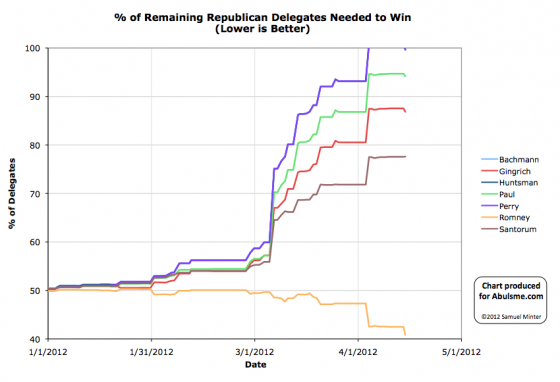
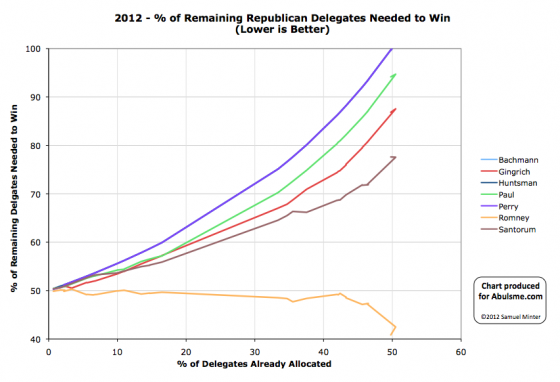
Charts from the Abulsme.com 2012 Republican Delegate Count Graphs page. When a candidate gets down to 0%, they have clinched the nomination. If they get above 100%, they have been mathematically eliminated. The first chart is by date, the second is by “% of Delegates Already Allocated”. These numbers include estimates of the eventual results of multi-stage caucus processes which will be refined as the later stages occur.
Wyoming and Colorado both have caucus type delegate allocation systems, where local caucuses earlier in the year are actually just the start of multi-month multi-stage processes. Both Colorado and Wyoming had their state conventions this weekend finishing off the delegate selection in those states.
Compared to the earlier estimates based on caucus results, the non-Romneys got crushed. Romney gained delegates. Everybody else lost delegates.
This is not surprising. It is common for the “clear winner” to end up taking far more delegates in the end than it looked like they would given the “straw poll” results at the first stage.
Looking more specifically…
- Colorado: The estimates after the caucuses were Santorum 13, Romney 12, Gingrich 4, Paul 4, and 3 uncommitted. This now becomes Romney 13, Santorum 6, and 17 uncommitted. All 36 delegates from Colorado are officially uncommitted, but using the current stated preferences of the delegates we have a net today from Colorado of Romney +1, Gingrich -4, Paul -4, Santorum -7.
- Wyoming: The estimates after the caucuses were Romney 11, Santorum 8, Paul 6, Gingrich 2, and 2 uncommitted. This now becomes Romney 22, Santorum 2, Paul 1, and 4 uncommitted. In Wyoming the delegates are bound. The net for the day in Wyoming is Romney +11, Gingrich -2, Paul -5, Santorum -6
Totaling the day we have Romney +12, Gingrich -6, Paul -9, Santorum -13. This does not look like a good day for the non-Romneys. Especially for Santorum. I guess dropping out of the race doesn’t help one’s ability to compete for delegates.
Notice though that we actually lost 16 delegates from the totals as some delegates that were predicted to go for specific candidates ended up uncommitted to any candidate. This actually increases the pool of potentially available delegates. In theory this improves the situation slightly for Gingrich and Paul, because, hey, they might still convince those uncommitted delegates to vote for them. (And indeed, some reports say many of those uncommitted delegates aren’t ready to support anybody else yet, but are not for Romney at this point either.) Santorum lost enough delegates that his situation actually gets worse anyway.
In terms of “% of remaining delegates needed to win”:
- Romney: 42.49% -> 40.85%
- Santorum: 77.56% -> 77.61%
- Gingrich: 87.54% -> 86.85%
- Paul: 94.70% -> 94.16%
I should also mention, that having these additional 16 delegates not committed brings the total number of delegates allocated by the estimates we use (the Green Papers soft count) back under 50% of the total number of delegates. Which actually means that the candidates with no delegates right now (Bachman, Huntsman, Perry, random others) are now no longer mathematically eliminated, and could catch up and win by capturing 99.65% of the remaining delegates. If they were actually on the ballot on all of the remaining states. Which they are not. :-)
So, uh, anyway… Romney still wins.
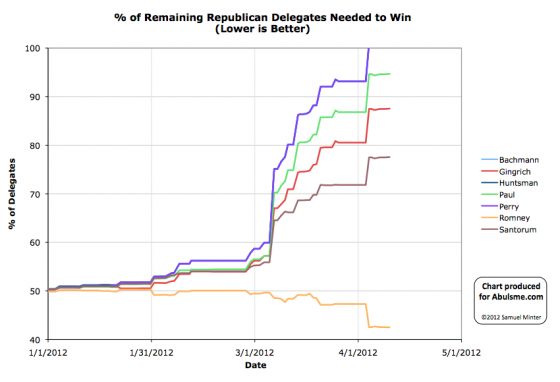
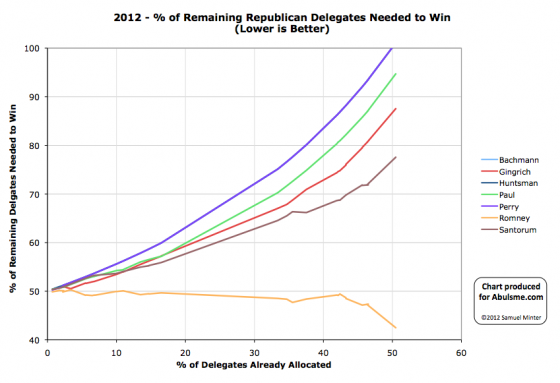
Charts from the Abulsme.com 2012 Republican Delegate Count Graphs page. When a candidate gets down to 0%, they have cinched the nomination. If they get up past 100%, they have been mathematically eliminated. The first chart is by date, the second is by “% of Delegates Already Allocated”. These numbers include estimates of the eventual results of multi-stage caucus processes which will be refined as the later stages occur.
You’d think the remaining superdelegates would be rushing in a mob to get on the Romney bandwagon at this point, but not so far. We have an additional super from Massachusetts today. Well, actually DCW identified the new super on Saturday, but it took Green Papers a few days to update their Massachusetts numbers. Since we go by Green Papers here, we waited. :-)
In any case, this is only one delegate, so only very minor changes to the “% of remaining needed to win” numbers:
- Romney: 42.54% -> 42.49%
- Santorum: 77.49% -> 77.56%
- Gingrich: 87.47% -> 87.54%
- Paul: 94.62% -> 94.70%
And now we continue to yawn and wait in the lull before the next actual contests. Not that there is much contest left anyway, but Romney still does need to mop up the rest of the 1144 delegates he needs.
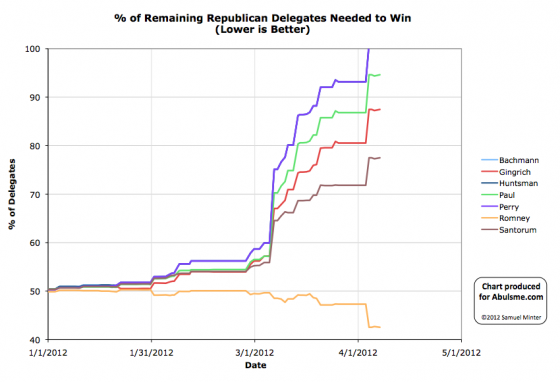
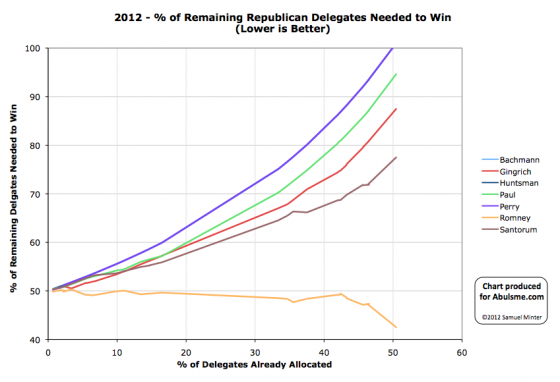
Charts from the Abulsme.com 2012 Republican Delegate Count Graphs page. When a candidate gets down to 0%, they have cinched the nomination. If they get up past 100%, they have been mathematically eliminated. The first chart is by date, the second is by “% of Delegates Already Allocated”. These numbers include estimates of the eventual results of multi-stage caucus processes which will be refined as the later stages occur.
So… remember yesterday when I removed three delegates from Romney’s column because Green Papers decided the three super delegates in Wisconsin were not bound by the primary results? Well, in today’s update they put them back. They are now officially “uncommitted” in their hard count, but are Romney in the soft count (which we use for these charts). The soft count indicates not just the official status, but other indicators of the ways the delegates are likely to vote.
In any case, this reverts things to how they were a couple days ago on our charts.
I’m sure Romney will breathe a lot easier with these three delegates back in his column. :-)
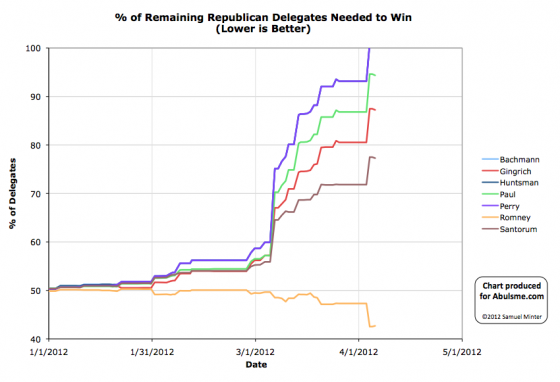
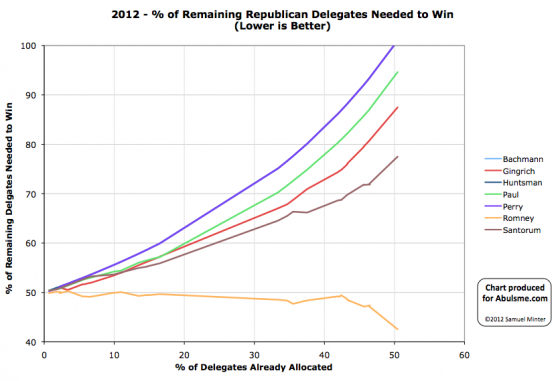
Charts from the Abulsme.com 2012 Republican Delegate Count Graphs page. When a candidate gets down to 0%, they have cinched the nomination. If they get up past 100%, they have been mathematically eliminated. The first chart is by date, the second is by “% of Delegates Already Allocated”. These numbers include estimates of the eventual results of multi-stage caucus processes which will be refined as the later stages occur.
So, Green Papers updated their Wisconsin numbers. They had been 33 Romney, 9 Santorum. They are now 30 Romney, 9 Santorum, 3 still available. Green Papers’ latest update commentary indicates that they had previously thought these superdelegates were bound by the primary results, but it turns out they are not. DCW still says however that those superdelegates are bound by the election results and don’t have independent free choice here, in which case they probably really should be in the Romney column. In fact DCW only made that change on the 4th. So I’m not really sure who is right here.
For purposes of our counts, we go with Green Papers though, so Romney loses the three delegates from his count. If information is found that these superdelegates are bound after all, Green Papers will update accordingly.
The changes to the “% of remaining delegates needed to win” number:
- Romney: 42.5% -> 42.7%
- Santorum: 77.5% -> 77.3%
- Gingrich: 87.5% -> 87.2%
- Paul: 94.6% -> 94.4%
So bad for Romney (since he loses 3 delegates for now) and good for everybody else since these delegates are theoretically now up for grabs again.
But really, this changes nothing.
Romney is the nominee.
Edit 2012 Apr 6 07:07 UTC to refer to both GP and DCW’s views on the 3 superdelegates being bound after I found GP’s comments on this.
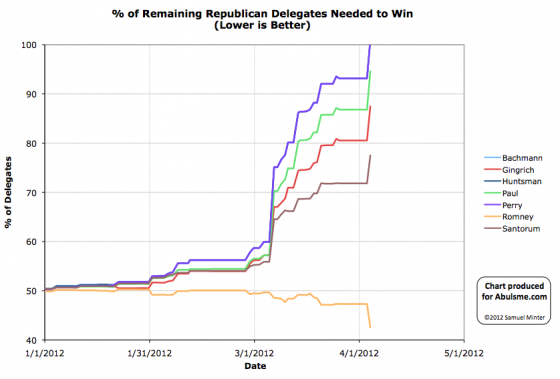
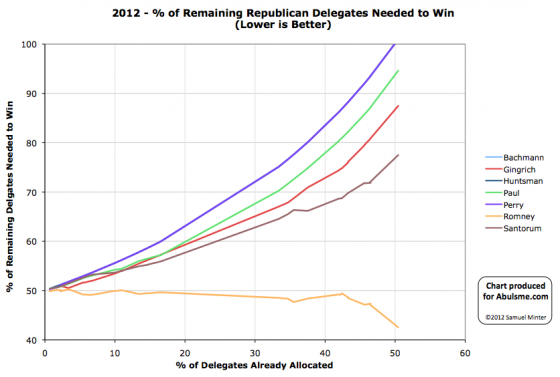
Charts from the Abulsme.com 2012 Republican Delegate Count Graphs page. When a candidate gets down to 0%, they have cinched the nomination. If they get up past 100%, they have been mathematically eliminated. The first chart is by date, the second is by “% of Delegates Already Allocated”. These numbers include estimates of the eventual results of multi-stage caucus processes which will be refined as the later stages occur.
So… this is it. Long ago any realistic possibility for any non-Romney to win the nomination disappeared. With today’s update the already long odds for the non-Romneys to keep Romney from getting to 1144 essentially drop to zero. This is over. Romney wins. Without any sort of brokered convention. For something else to happen now we’d need some event that was so earth shaking that Romney dropped out. This is extremely unlikely.
Details below.
We have updates from four contests. In alphabetical order:
- DC: DC is winner take all, Romney gets all 16 delegates.
- Maryland: Maryland is not actually winner take all, you get some delegates for winning the state, and then more delegates go to the winner of each congressional district. But Romney not only won the state, but every congressional district. So Romney gets all 37 delegates.
- North Dakota: North Dakota had the first round of its process in March. At that time the delegate estimate was Santorum 11, Paul 8 , Romney 7 , Gingrich 2. But the state Republican Convention happened last weekend, and Romney supporters owned the parliamentary process, taking the lion’s share of the delegates despite coming in third in March. That’s how it works in caucus states sometimes. It took a couple days for Green Papers to confirm a new estimate, but it now looks like Romney 20, Santorum 6, Paul 2. So the net today is Romney +13, Gingrich -2, Santorum -5, Paul -6.
- Wisconsin: Wisconsin also allocates some delegates based on both state and CD winners. Romney won the state. Romney won 5 CDs. Santorum won 3 CDs. So overall we have a delegate count of Romney 33, Santorum 9
Add those up and we have a net total for today of Romney +99, Santorum +4, Gingrich -2, Paul -6 Obviously Romney completely dominated the day.
In terms of “% of remaining delegates needed to win” we have this:
- Romney: 47.3% -> 42.5%
- Santorum: 71.8% -> 77.5%
- Gingrich: 80.5% -> 87.5%
- Paul: 86.8% -> 94.6%
The also-rans who left the race early on… Bachman, Huntsman and Perry… are mathematically eliminated after today. Paul, Gingrich and Santorum will inevitably join them soon.
The blocking Romney option? At this point the non-Romneys collectively would need to get 57.5% of the remaining delegates. So far they have managed 42.6% of the delegates. A change of this sort, while not mathematically impossible, would be unprecedented, especially since we are in the phase of the campaign where it is clear Romney is winning and the others are losing. People just stop voting for losers. As things go on, the % of delegates the non-Romneys get will probably actually decline. A major increase is just not going to happen.
It is over.
(We will of course continue to update these charts until Romney actually gets to 1144 however.)
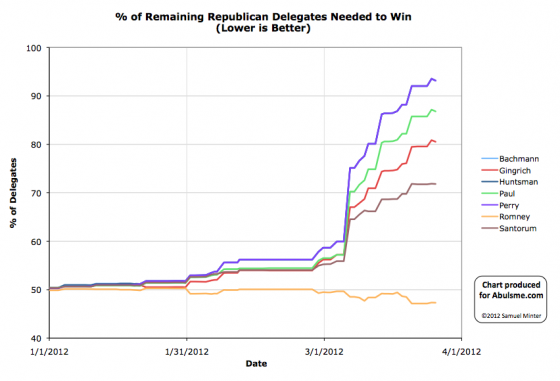
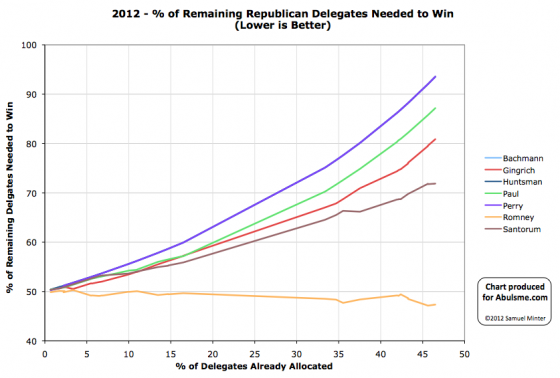
Charts from the Abulsme.com 2012 Republican Delegate Count Graphs page. When a candidate gets down to 0%, they have cinched the nomination. If they get up past 100%, they have been mathematically eliminated. The first chart is by date, the second is by “% of Delegates Already Allocated”. These numbers include estimates of the eventual results of multi-stage caucus processes which will be refined as the later stages occur.
I mentioned yesterday that there was some disagreement on interpretation of the rules for how delegates would be allocated in Louisiana. Green Papers said Santorum 13, Romney 7. @FHQ said Santorum 10, Romney 5 and some uncommitted delegates. My charts use the Green Papers Numbers. Well, since yesterday’s update the Louisiana Republican party weighed in… and it was 10-5, not 13-7. So @FHQ was right and wins that argument. So Green Papers updated their numbers.
So, net for today: Santorum -3, Romney -2.
This adjusts the numbers slightly, but does not change yesterday’s conclusions. Both Romney and Santorum didn’t do as well as they needed in Louisiana to move toward 1144. So it was still an “everybody loses” contest. Just slightly different numbers.
For today’s adjustment, the “% of remaining needed to win” changes like this:
- Romney: 47.34% -> 47.31%
- Santorum: 71.87% -> 71.82%
- Gingrich: 80.87% -> 80.54%
- Paul: 87.16% -> 86.81%
So essentially today is an “everybody wins!” day, simply because there are 5 more delegates available today compared to what was thought to be available yesterday.
The race summary remains the same. The non-Romneys are rushing toward mathematical elimination. It would take an event like Romney dropping out to give them an actual shot to get to 1144 before the convention. The most likely scenario remains Romney slowly but surely accumulating delegates and getting to 1144. The possibility of the non-Romneys blocking Romney from getting to 1144 remains remote, but not yet so remote that I’m ready to say outright that it is impossible.
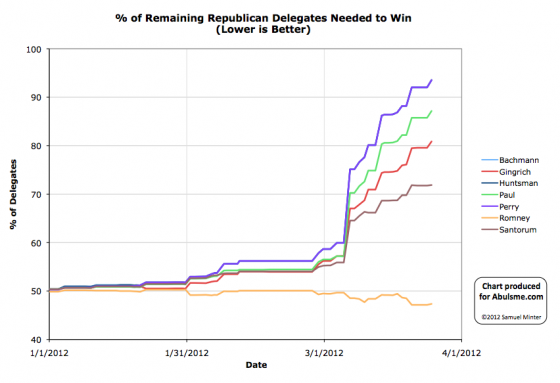
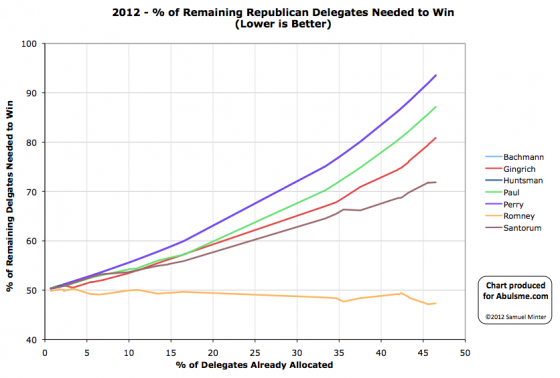
Charts from the Abulsme.com 2012 Republican Delegate Count Graphs page. When a candidate gets down to 0%, they have cinched the nomination. If they get up past 100%, they have been mathematically eliminated. The first chart is by date, the second is by “% of Delegates Already Allocated”. These numbers include estimates of the eventual results of multi-stage caucus processes which will be refined as the later stages occur.
So, Santorum has a “big win” in Louisiana. But, unfortunately for him, not big enough. Green Papers’ Louisiana Results give 13 delegates to Santorum and 7 to Romney. Gingrich and Paul get nothing. Louisiana also has 26 more delegates that will be determined by other means. (Note that there is some question on interpretation of the delegate rules. @FHQ says 10 Santotum, 5 Romney and some uncommitted delegates. We use Green Papers as our source, and they will update if it becomes clear their interpretation of the rules was wrong.)
So with a 13-7 split, that is 65% Santorum. To actually be on a pace to catch up and win, he needed to get 71.8% of the delegates. Didn’t happen. Thus with his “big win” Santorum still moves closer to mathematical elimination. That is some win!
Of course, Romney also didn’t get the delegate levels he needed to be on the pace he needs. He needed 47.1% of the delegates. The 35% he gets with his 7 delegates is well below that.
So, it’s an “everybody loses!” day. Bottom line is that Louisiana doesn’t change much. The three non-Romney’s are racing inevitably toward elimination. They are just too far behind to catch up absent something as major as Romney dropping out of the race… which I don’t think Romney is thinking about doing at this point. Meanwhile, Romney is in a position to eventually win just by continuing to collect delegates at the same pace he has been. Romney has collected 53% of the delegates so far. If he just keeps chugging at those margins, he’ll get to 1144 eventually. But… the non-Romney’s collectively have gotten 47% of the delegates. If they can up that to 53%, then they can still collect enough delegates to block Romney.
47% to 53% is a big move in a political race. But it is still not out of the realm of the possible. (It is getting close though.) A few big slips by Romney. One of the non-Romney’s doing something really impressive. It COULD happen. It is unlikely though. As I’ve said before here, as it becomes clear that none of the non-Romney’s can actually win, it will be harder and harder for them to actually get delegates. So it is far more likely that the percentage of delegates the non-Romneys can manage will decline as we go forward.
“% of remaining needed to win” update based on today’s numbers:
- Romney: 47.1% -> 47.3%
- Santorum: 71.8% -> 71.9%
- Gingrich: 79.6% -> 80.9%
- Paul: 85.8% -> 87.2%
We’re still not quite to the half way mark. 46.5% of the delegates allocated (or estimated) at this point.
Next up: DC, Maryland, Wisconsin on April 3rd. All winner take all states, so likely to have a bigger impact.
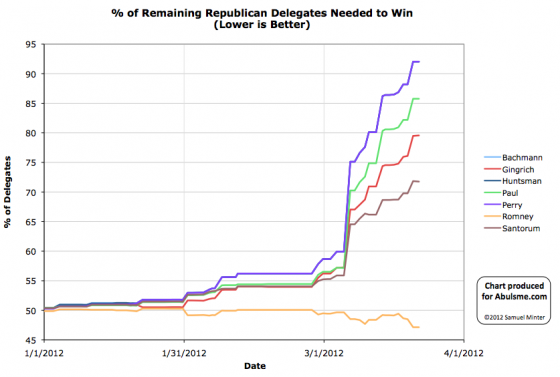
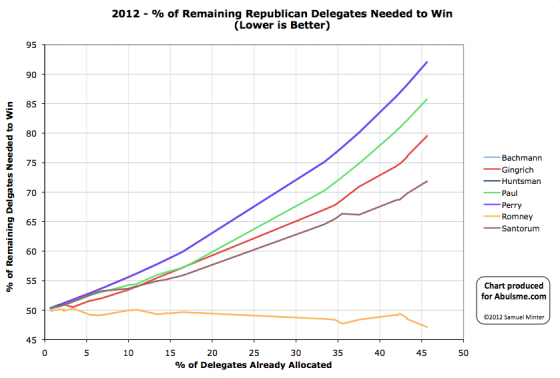
Charts from the Abulsme.com 2012 Republican Delegate Count Graphs page. When a candidate gets down to 0%, they have cinched the nomination. If they get up past 100%, they have been mathematically eliminated. The first chart is by date, on the second chart rather than the date on the x-axis, we show the “% of Delegates Already Allocated” as this better represents the progress through the race. Note that these numbers include estimates of the eventual results of multi-stage caucus processes which will be refined as the later stages occur.
Right after the caucuses there, delegates from Alaska were estimated as Romney 8, Santorum 7, Paul 6, Gingrich 3. The district Convention vote is now final, and the estimate changes to Romney 8, Santorum 8, Paul 6, Gingrich 2. So net for the day: Santorum +1, Gingrich -1. (The three superdelegates from Alaska are still up for grabs.)
This of course doesn’t substantially change anything.
(For the die hards: Santorum’s % of remaining needed to win declines from 71.84% to 71.76%, while Gingrich’s rises from 79.49% to 79.57%.)
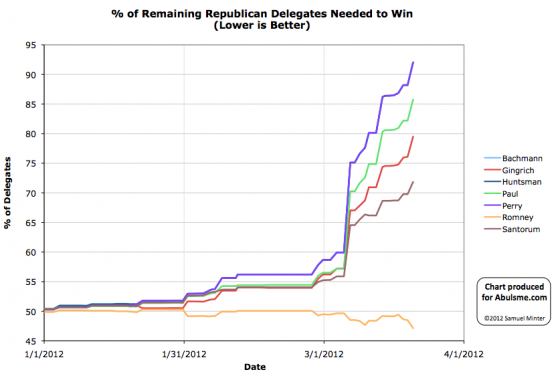 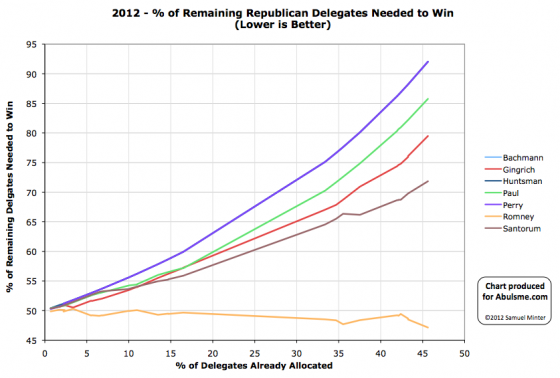
Charts from the Abulsme.com 2012 Republican Delegate Count Graphs page. When a candidate gets down to 0%, they have cinched the nomination. If they get up past 100%, they have been mathematically eliminated. The first chart is by date, on the second chart rather than the date on the x-axis, we show the “% of Delegates Already Allocated” as this better represents the progress through the race. Note that these numbers include estimates of the eventual results of multi-stage caucus processes which will be refined as the later stages occur.
So this looks like it might be it. As I indicated might be a possibility in yesterday’s update, between Romney’s lead growing rapidly in recent polls and Santorum failing to file proper delegate slates everywhere, Romney did indeed do well enough to be moving in the direction of getting to 1144. (In fact he blew away the percentages he needed to get for that.) He is now in the best position he has been in since the race began, and the chances of any brokered convention shenanigans are receding quickly.
Lets look at the specifics.
With 99% of precincts reporting, Romney has 46.7% of the popular vote in Illinois. But because of the specifics of how delegates are allocated, and Santorum’s failure to have delegate slates everywhere, this translates into getting 42 of the 54 delegates that were up for grabs tonight. That is 77.8% of the delegates. WELL above the 48.5% of delegates he needed to improve his position overall.
Santorum gets the other 12 delegates allocated tonight. Gingrich and Paul are shut out and get nothing.
Also today the one Puerto Rican superdelegate who had previously endorsed Gingrich decides to echo the election results there, says it is “time to unite” and switches his endorsement to Romney.
This makes the totals for today: Romney +43, Santorum +12, Gingrich -1
And looking at “% of remaining delegates needed to win”:
- Romney: 48.5% -> 47.1%
- Santorum: 69.8% -> 71.8%
- Gingrich: 76.1% -> 79.5%
- Paul: 82.2% -> 85.8%
Looking at the charts at the top of this post, between Puerto Rico and Illinois, Romney is finally starting to really drive down this number. His line is finally starting to move downward rapidly. The three non-Romneys continue their race toward mathematical elimination. It won’t be long now.
How about the possibilities for blocking Romney? Well, at this point the combined non-Romneys would need to consistently get 52.9% of the remaining delegates in order to be on a pace to stop Romney from getting to 1144. Up to this point the non-Romney’s have managed 46.5% of the delegates. Making the jump from 47% to 53% is a big jump, but still not an unimaginable jump. Perhaps with a few major Romney stumbles in a row? And a few good states in a row? Louisiana maybe? The RCP average for Louisiana has the non-Romneys at 56%. If the popular vote ends up like that, and the delegates parallel the popular vote…
Well, yes, Romney may not get what he needs in Louisiana. But after that the calendar starts looking better for Romney again. And with it being essentially 100% clear at this point that none of the non-Romneys have a chance at 1144 (despite what Santorum’s camp was saying recently) and it is all just about blocking Romney, do people continue to vote for candidates who are clearly losing? And perhaps just as importantly, do rich donors still throw millions at candidates who clearly are going nowhere? Probably not.
It has taken awhile, but it really does look like Romney is finally starting to put the chances of being blocked in the rear view mirror. I’m not ready to call it impossible quite yet. But it is getting closer to that point and is already very unlikely. We can already say that the non-Romney’s getting it together enough to block Romney would require a major change to how they’ve been doing so far, and a reversal of recent trends.
Once Romney’s “% of remaining needed to win” drops below 45% or so we can pretty safely call this a done deal absent a major catastrophe. From then on out, it will just be Romney slowly but surely grinding his way to 1144. But we aren’t there quite yet.
Lets see how Louisiana, DC, Maryland and Wisconsin go. (Those last three are winner take all, so April 3rd will be a big day!)
This of course does mean that Santorum is now the frontrunner to be the 2016 Republican nominee. (Since Romney will lose to Obama in November according to current polling, and by coming in 2nd this time around, Santorum would be “next in line” on the Republican side.)
Too soon?
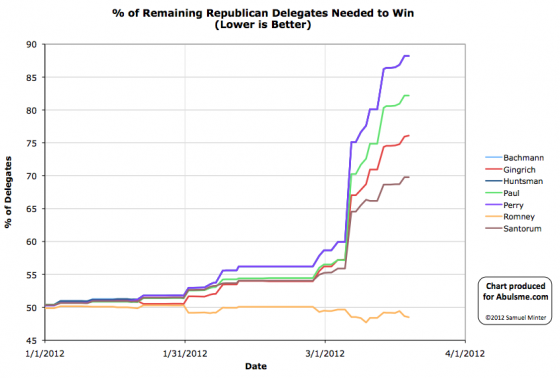
Chart from the Abulsme.com 2012 Republican Delegate Count Graphs page. When a candidate gets down to 0%, they have cinched the nomination. If they get up past 100%, they have been mathematically eliminated. Note that these numbers include estimates of the eventual results of multi-stage caucus processes which will be refined as the later stages occur.
A minor update from Georgia today. My primary source, Green Papers, previously had the results from Georgia as Gingrich 54, Romney 19, Santorum 3. This has now been updated to Gingrich 52, Romney 21, Santorum 3.
So the net for the day is Romney +2, Gingrich -2.
So Romney’s “% of remaining needed to win” drops from 48.7% to 48.5%. (And Gingrich’s rises from 75.9% to 76.1%.)
This is a minor change that does not change the state of the race significantly. But since there is an update today, it gives me a chance to modify something I said in the last update based on new information. I had said:
Next up is Illinois. Romney is ahead in the polls in Illinois, but isn’t over 48.7% in those polls, and of course nobody else is close to the numbers above either. The contest there is a “Loophole Primary” which is a bit odd, but if the delegate results are even close to being proportional to the popular vote result, then we can expect Illinois to be another of the “everybody loses” states where nobody actually gets closer to the nomination in terms of being on pace to win.
Well. two things.
First, recent polls have been moving in Romney’s direction over the last week. The most recent poll as of this writing was a poll from PPP (pdf) that has Romney at 45%. Now, polls predict popular vote, not delegates, and the 48.5% Romney needs is a percentage of delegates, not a percentage of the popular vote. But assuming at least some correlation between popular vote and delegates, those numbers are getting pretty close to each other. Which brings us to…
Second, Santorum failed to properly file for delegate slates in some parts of the state. This means that Santorum’s delegate take will almost certainly underperform his performance in the popular vote. This implies that Romney’s delegate take may well overperform his popular vote number.
With these two factors together, Romney’s chances of getting to the 48.5% he needs to improve his “% of remaining” number and move closer to the nomination and further away from the scenarios where he doesn’t get to 1144 is much more likely than it looked previously.
By this time tomorrow, we should know how that turned out.
|
|


















